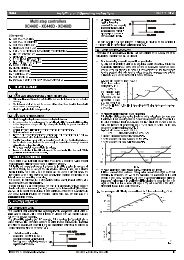The Refrigeration Load - HVAC and Refrigeration Information Links
The Refrigeration Load - HVAC and Refrigeration Information Links
The Refrigeration Load - HVAC and Refrigeration Information Links
You also want an ePaper? Increase the reach of your titles
YUMPU automatically turns print PDFs into web optimized ePapers that Google loves.
Section 12HEAT TRANSMISSION<strong>The</strong> heat gain through walls, floors <strong>and</strong> ceilings will varywith the type of construction, the area exposed to a differenttemperature, the type of insulation, the thicknessof insulation, <strong>and</strong> the temperature difference betweenthe refrigerated space <strong>and</strong> the ambient air.In catalog <strong>and</strong> technical literature pertaining to heattransfer, certain letter symbols are commonly used todenote the heat transfer factors, <strong>and</strong> a working knowledgeof these symbols is frequently necessary to easilyinterpret catalog data.TRANSMISSION HEAT LOAD — Q<strong>The</strong> basic formula for heat transfer through some heattransfer barrier is:Q = U x A x TDQ = Heat transfer, BTU/HrU = Overall heat transfer coefficientBTU/(hour)(sq. ft.)(°F TD)A = Area in square feetTD = Temperature differential betweensides of thermal barrier, forexample, between outside designtemperature <strong>and</strong> the refrigeratedspace temperature.Q is the rate of heat flow, the quantity of heat flowingafter all factors are considered.THERMAL CONDUCTIVITY — k<strong>The</strong>rmal conductivity, k, is defined as the rate of heattransfer that occurs through a material in units ofBTU/(hr)(square foot of area)(°F TD) per inch of thickness.Different materials offer varying resistances tothe flow of heat.For example, the heat transfer in 24 hours through twosquare feet of material three inches in thickness havinga thermal conductivity factor of .25 with an averagetemperature difference across the material of 70°Fwould be calculated as follows:.25(k) x 2 sq. ft. x 24 hours x 70° TDQ = 3 inches thickness = 280 BTUSince the total heat transferred by conduction variesdirectly with time, area, <strong>and</strong> temperature difference, <strong>and</strong>varies inversely with the thickness of the material, it isreadily apparent that in order to reduce heat transfer,the thermal conductivity factor should be as small aspossible, <strong>and</strong> the material as thick as possible.THERMAL RESISTIVITY — r<strong>The</strong>rmal resistivity is defined as the reciprocal of thermalconductivity of 1/k. “r” is of importance because resistancevalues can be added numerically.R total = r 1+ r 2+ r 3Where r 1, r 2, <strong>and</strong> r 3are individual resistances. Thismakes the use of r convenient in calculating overallheat transfer coefficients.CONDUCTANCE — C<strong>The</strong>rmal conductance is similar to thermal conductivity,except that it is an overall heat transfer factor fora given thickness of material, as opposed to thermalconductivity, k, which is a factor per inch of thickness.<strong>The</strong> definition is similar, BTU/(hour)(square foot ofarea)(°F TD).THERMAL RESISTANCE — R<strong>The</strong>rmal resistance is the reciprocal of conductance, 1/Cin the same way that thermal resistivity is the reciprocalof conductivity.SURFACE FILM RESISTANCEHeat transfer through any material is affected by thesurface resistance to heat flow, <strong>and</strong> this is determinedby the type of surface, rough or smooth; its position,vertical or horizontal; its reflective properties; <strong>and</strong> therate of airflow over the surface. Surface film conductance,normally denoted by f ifor inside surfaces <strong>and</strong> f ofor outside surfaces is similar to conductance.However, in refrigeration work with insulated walls, theconductivity is so low that the surface film conductancehas little effect, <strong>and</strong> therefore, can be omitted from thecalculation.OVERALL COEFFICIENT OF HEATTRANSFER — U<strong>The</strong> overall coefficient of heat transfer, U, is defined asthe rate of heat transfer through a material or compoundstructural member with parallel walls. <strong>The</strong> U factor,as it is commonly called, is the resulting heat transfer12-1© 1968 Emerson Climate Technologies, Inc.All rights reserved.
















